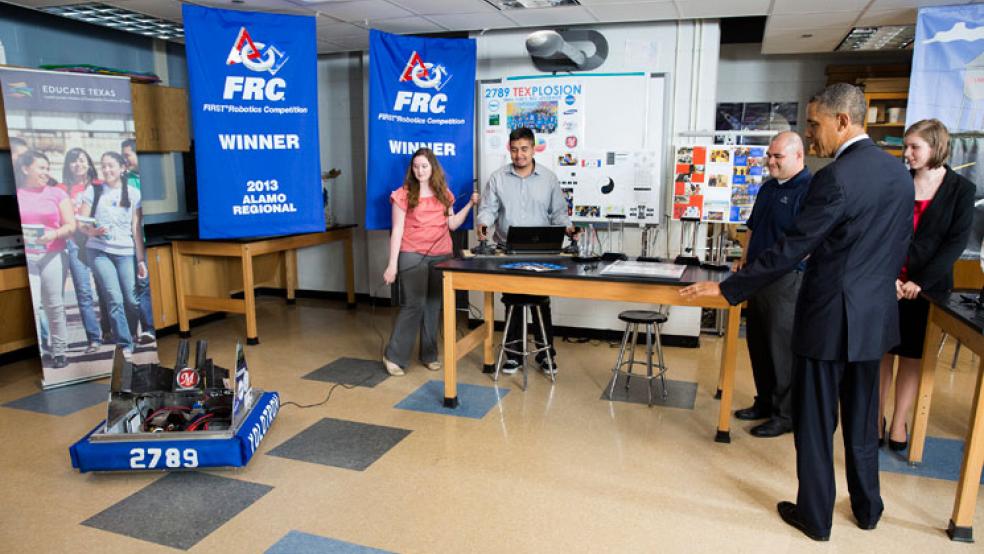Is President Obama’s push for more STEM grads and increased H-1B visas payback to the tech companies that got him re-elected? It seems possible. While the likes of Google and Microsoft have been sounding alarms over a shortage of technical workers, other research indicates that in fact we may have too many college graduates with degrees in science and math. Critics charge that
They argue that there are hundreds of thousands of engineers and scientists without jobs, and plenty in the pipeline. Others, including Obama, claim the opposite — that we face a looming shortage of the tech-savvy graduates vital to keeping the U.S. competitive in the years ahead.
RELATED: THE NEW UNIVERSITY CURRICULUM - JOB TRAINING
How can there be such contradictory soundings? Because most of the analysis done on the topic is by groups with an obvious agenda. This we know for sure: President Obama owes much to Silicon Valley, and
It is no secret that numerous tech leaders — including Google’s Eric Schmidt — contributed manpower and talent to the extensive data mining and analytics of the successful Obama team. The president’s promotion of ramped-up STEM education and an expanded H-1B visa program seems an obvious thank you.
A recent piece in the Chronicle of Higher Education by Michael Anft notes that most of the reports urging schools to expand their science and math offerings have been underwritten by the technology industry.
Most research not funded by Silicon Valley finds that other than petroleum engineers currently benefiting from the fracking boom, most STEM grads — those specializing in chemistry or mechanical engineering, for instance — have seen flat or falling wages, suggesting a labor surplus.
At a recent Congressional hearing on H-1B visas, Hal Salzman, professor of Public Policy at Rutgers University, reports that we are educating 50 percent more IT grads every year than there are job openings. Salzman cites a report he co-authored last April for the left-leaning Economic Policy Institute which concluded, “The United States has more than a sufficient supply of workers available to work in STEM occupations.” The study noted that the flow of students into STEM fields has been strong over the past decade, and that “the number of
A report this past spring from Georgetown University’s Public Policy Institute ranked unemployment by majors: almost 15 percent of recent Information Systems graduates were without work, the highest of any major, compared to 7.9 percent for college graduates overall. Nearly 9 percent of computer science majors were unemployed, compared to 4.8 percent for nursing, for instance.
Joblessness for STEM workers tend to be lower than for the population overall, but has risen over the past few years. Further, from 2000 to 2011, the average hourly wage for workers with a bachelor’s or advanced degree in computer and math occupations rose less than half a percent per year — from $37.27 to $39.24 in 2012 dollars. Surely if there were an acute shortage of such laborers, wages would have jumped more sharply.
RELATED: MILLENNIALS' TOP CAREER GOAL: TO BE INSPIRED
Why then the push for more STEM students? There is no question that it behooves
Anft notes that universities are happy to pile onto the STEM shortage narrative, since they often partner profitably with the tech industry, and receive about half of the federal government’s $3.1 billion STEM budget. Colleges win grants from numerous federal agencies, such as NASA and the National Science Foundation, to build up their STEM programs.
President Obama, siding with Silicon Valley, has called for the government and industry to train 1 million new U.S. engineers over the coming decade and turn out an additional 100,000 STEM teachers by 2020. The president has also endorsed allowing more tech-savvy foreigners to stay in the
What really makes no sense is Obama’s confidence that he should direct what kids study. Young Americans are already lining up for promising professions of their own accord, supplying plenty of talented tech workers. If we want colleges to keep turning out the skills we need, best to let the self-interest of the next generation propel enrollments higher — and it will. Once again it is appealing, and likely fruitless, to urge President Obama to trust in the marketplace.
Top Reads from The Fiscal Times:






